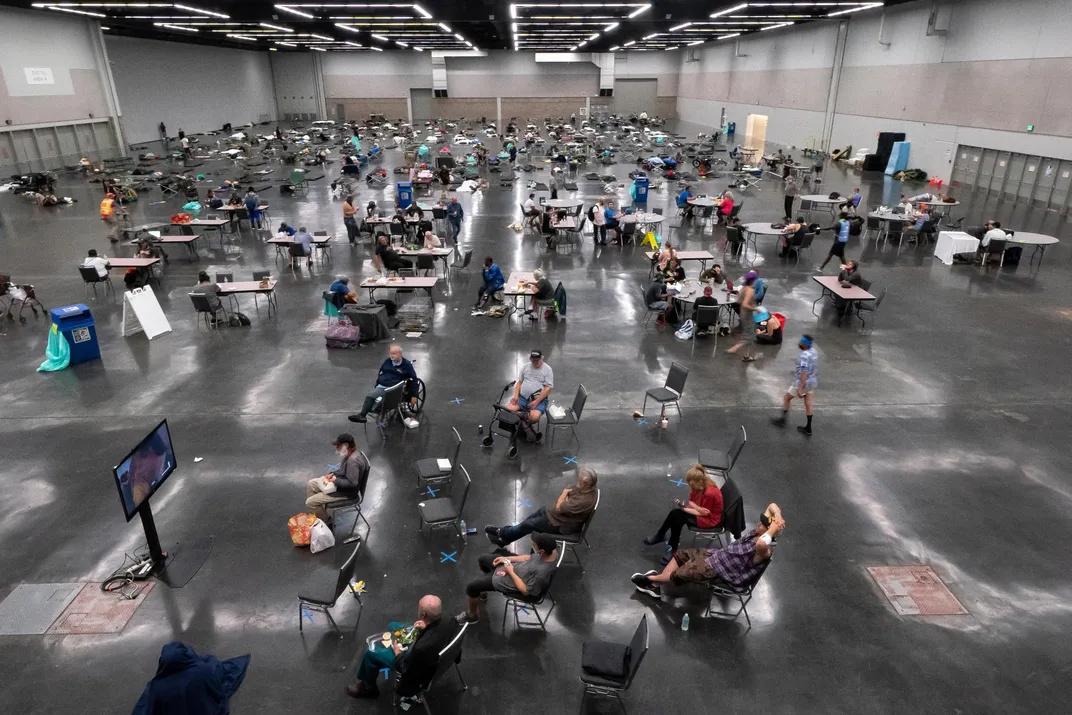Heat Dome Scorches Pacific Northwest With Record-Breaking High Temperatures
Cities in Oregon and Washington have surpassed 100 degrees Fahrenheit for several consecutive days
/https://tf-cmsv2-smithsonianmag-media.s3.amazonaws.com/filer/4a/4e/4a4e6df2-042b-44c8-adc6-148c57019fed/gettyimages-1233694107.jpg)
An intense heat dome shattered records in the Pacific Northwest over the weekend—and temperatures are still rising. Millions of residents are under excessive heat warnings, with temperatures surpassing 100 degrees Fahrenheit. The skyrocketing temperatures have created unsafe conditions for people in a region not accustomed to battling heat waves, reports Jeff Berardelli for CBS News.
Washington state reached its all-time high for June at 115 degrees Fahrenheit on Sunday. Seattle and Portland both obliterated records when temperatures reached 104 degrees Fahrenheit and 112 degrees Fahrenheit, respectively, over the weekend, reports Hallie Golden for the Guardian. On Monday, records broke again when temperatures spiked to 115 degrees Fahrenheit at the Portland International Airport, reports Neil Vigdor for the New York Times. In Salem, Oregon, temperatures reached 117 degrees Fahrenheit on Monday afternoon, shattering the previous hottest record of 108 degrees Fahrenheit set in 1941 and 1927, reports Anne C. Mulkern for E&E News.
The unusual heatwave was caused by a weather phenomenon called a heat dome. A heat dome is an area of high pressure that looms over regions like a lid on a pot of boiling water, reports Sarah Gibbens for National Geographic. Heat domes occur when weather events like La Niña cool waters in the eastern Pacific and warm waters in the western Pacific. The temperature difference causes winds to blow tropical air eastward. The warm air then creates a jet stream that spins clockwise around the world and ends up on west coast of the United States, per National Geographic.
WATCH: @WeatherProf has more on the extreme heat in the Pacific Northwest and how climate change is contributing to the record breaking temperatures. pic.twitter.com/Lupr6CLP0L
— CBS This Morning (@CBSThisMorning) June 28, 2021
The jet stream—along with a heatwave formed by two pressure systems engulfing Oregon and Washington—created the heat dome, which was intensified by rising temperatures associated with climate change. The Pacific Northwest has already warmed three to four degrees since the industrial revolution, CBS News reports.
Heat waves are detrimental to regions known for moderate temperatures. Large portions of the populations in these locations do not have air-conditioned households because the areas often see mild summers, reports E&E News. Average temperatures for this time of year in Portland usually remain in the 70s, reports Scott Neuman for NPR.

According to the 2019 American Housing Survey, Seattle ranks as the least air-conditioned city compared to 15 other top metro areas, NPR reports. Nationally, 91 percent of U.S. homes have air conditioning installed, according to the survey. However, in Seattle, this figure drops to 44 percent, and in Portland, 78 percent of households have air conditioning. Lack of air conditioning is one contributing factor that causes heatstroke, a condition where the body overheats from prolonged exposure to high temperatures and can lead to death, per NPR.
Residents looking for relief have flocked to pools, beaches, and air-conditioned hotels. Cooling centers like public libraries and community centers have been established in cities like Seattle and Portland to help residents get some relief from the heat, reports National Geographic. Covid-19 limits on the number of people allowed in places such as malls, swimming pools, and movie theaters were lifted by the Oregon Health Authority, reports the New York Times. The heatwave is expected to ease along coastal regions in Seattle and Portland on Tuesday, but it will likely last the rest of the week in areas farther away from coasts in the Pacific Northwest, reports CBS News.
/https://tf-cmsv2-smithsonianmag-media.s3.amazonaws.com/accounts/headshot/gamillo007710829-005_0.png)
/https://tf-cmsv2-smithsonianmag-media.s3.amazonaws.com/accounts/headshot/gamillo007710829-005_0.png)